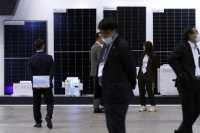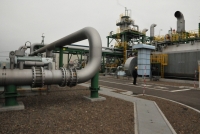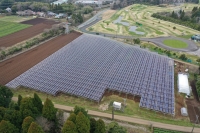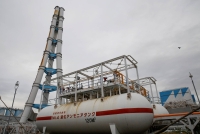Japan is asking investors to stump trillions of yen over the next decade to back its efforts to tackle climate change. But both investor groups and climate change experts are concerned about the decarbonization merits of the projects the world’s first sovereign “transition bonds” will be supporting.
These special sovereign bonds, which were issued for the first time last month, are intended to fund a wide variety of projects and technologies that are expected to help accelerate Japan’s shift to carbon neutrality by 2050.
As part of its green transformation strategy, Japan plans to attract about ¥150 trillion ($997 billion) in investment from both the private and public sectors. To stimulate investment by the former, the government will issue Japan Climate Transition Bonds worth a total of ¥20 trillion over the next 10 years.
The new policy is seen as an indication of Japan’s commitment to cultivating a greener path, and in that sense the bonds have been welcomed. But there is concern over the length of time it would take for a number of supported projects to be of practical benefit. For others, it’s not even clear they would actually contribute to decarbonization.
Such projects include promoting the use of ammonia for thermal power and developing next-generation nuclear reactors.
The former can still lead to greenhouse gas emissions — either by the production process or when it isn't burned correctly — while for the latter, it remains to be seen whether they will deliver on their promise.
“There are certainly high risks that technological innovation may fail. ... In cases where (supported projects) end up not being effective for decarbonization, the bonds would eventually end up as greenwashing,” says Hideo Oshima, a senior economist at the Japan Research Institute who tracks climate change issues.
Aina Fukuda, the head of Japan Investment Stewardship at Legal & General Investment Management Japan, says that it is welcome that Japan now views measures to tackle climate change as opportunities for economic growth, rather than merely as costs.
But certain projects expected to be funded by the transition bonds cast doubt on the initiative’s capacity to address the global climate crisis, she adds.
“What concerns us most is that it is hard to see a clear roadmap to the phasing out of the use of fossil fuels; rather, it will likely be prolonged,” Fukuda says.
Co-firing concerns
Japan’s plan to facilitate the research and development of ammonia or hydrogen co-firing has been criticized by a number of environmental groups who see it as a move to prolong the life of coal-fired plants. They are also doubtful that ammonia would be as cost effective as renewables like wind and solar, which have seen massive declines in prices over the past decade.
The government says it is important to explore new technologies because Japan cannot rely too heavily on renewables due to the limited availability of land and frequent earthquakes and typhoons. Rapidly phasing out fossil fuels would put a stable energy supply at risk, the industry ministry has said.
Japan’s top power producer Jera plans to start the world's first trial of 20% ammonia co-firing with coal at its Hekinan plant in Aichi Prefecture this month.
The government says ammonia and hydrogen are key to realizing a carbon-free future, as they typically do not produce carbon emissions when used as fuel for power generation. However, their production can lead to emissions, and shifting to 100% ammonia or hydrogen as fuel at coal-fired plants is expected to take over a decade, as developing the stable and vast supply chains needed is highly challenging.
Independent research also contends that a shift to an energy mix dominated by renewable energy is a possibility for Japan. The Renewable Energy Institute and the Lawrence Berkeley National Laboratory, for example, respectively say that renewable energy could make up 80% or 70% of energy generation by 2035.
“As government officials are also aware, I’m under the impression that few investors globally are convinced that the promotion of thermal power generation utilizing co-firing technology of ammonia and hydrogen is suitable for inclusion in the list of investment projects covered by the transition bonds,” Fukuda says.
Indeed, a report by the Principles for Responsible Investment, a United Nations-backed group, also says that some projects covered by the bonds may not be effective.
“(Japan’s) green transformation transition bonds may include co-firing power generation with coal and the use of grey hydrogen” the report says, referring to hydrogen generated from natural gas where the resulting carbon dioxide emissions are not captured. “This could lead to risks of greenwashing as well as potentially being a more costly route towards decarbonization.
“Many investors will expect clear guidelines and use of proceeds frameworks for the transition bonds, and a lack of transparency may not attract investor interest and creates investor risk.”
Responding to such concerns, the government did not include ammonia fuel projects in those to be funded by the transition bonds sold in February. The government has allocated a separate budget for ammonia fuel technology, so at this point it does not really expect that it will be covered by the bonds, an industry ministry official says.
As for the promotion of next-generation nuclear reactors, some investors have questioned if it’s worthwhile for Japan — which is still reckoning with nuclear power after the 2011 meltdowns at the Fukushima No. 1 plant — to increase reliance on the energy source considering the costs and safety risks.
Weaker than expected
The sale of about ¥800 billion worth of 10-year transition bonds took place on Feb. 14 and were priced to yield 0.74%, while another ¥800 billion in five-year bonds were sold last week and priced to yield 0.339%.
Compared with the yields of regular five- and 10-year bonds, the figures for the transition bonds were lower, indicating a premium, but market observers say that demand was weaker than expected. Yields on bonds move inversely to prices.
“The bidding was a bit sluggish, probably due to growing expectation that the Bank of Japan will start normalizing its monetary policy and interest rates will rise,” Takahide Kiuchi, executive economist at the Nomura Research Institute, said in a blog post published after the Feb. 14 sale.
“Also, investors might be seeing a liquidity risk, because the transition bonds are issued separately from regular Japanese government bonds and the scale is just ¥800 billion.”
Finance Minister Shunichi Suzuki said last week that he is aware of greenwashing criticisms, but “I was informed that many investors have shown understanding on the importance of the transition.”
“We hope the world’s first sovereign transition bond will play a role in increasing understanding of Japan’s green strategy and stimulate transition finance within Japan and overseas.”
Industrial competitiveness
Skepticism will likely remain among investors, however, as Japan’s green strategy has been seen more as an industrial policy aimed at boosting companies’ competitiveness.
By attracting investments in projects that could produce game-changing innovation, Japan apparently aims to gain an advantage in the global energy market and bolster its energy security.
In fact, the government says in the Japan Climate Transition Bond Framework document that technologies that are “particularly effective at enhancing industrial competitiveness and economic growth” would be given priority.
Oshima says that it is necessary to support and invest in industries’ green transformation technologies, but “it’s a different story whether that will really lead to cutting emissions.”
It is not that Japan is unwilling to bet on renewables, given that the country plans to pour ¥20 trillion into them over the next decade — a figure that is much higher than the ¥7 trillion for ammonia and hydrogen as well as the ¥1 trillion for next-generation nuclear reactors.

Among the renewables covered by the transition bonds are cutting-edge solar cells and floating offshore wind, and there are also projects that will help slash emissions, such as encouraging the adoption of electric vehicles and zero-emission houses and buildings.
But Oshima says that Japan’s green strategy should see the country invest in more measures that can firmly reduce emissions in the next five or 10 years.
Some investors have pointed out that it is unclear if Japan’s green transformation strategy is really in line with the Paris Agreement, which set a goal of holding the increase in global average temperatures to less than 2 degrees Celsius above pre-industrial levels and pursuing efforts to limit the rise to 1.5 C.
Climate Action Tracker rates Japan’s policies as “insufficient,” meaning the country needs “substantial” improvement to be aligned with the 1.5 C target.
“To limit the increase to 1.5 degrees, it is key to significantly reduce emissions in the next five to 10 years, but there appears to be a time lag because various projects and technologies emphasized in Japan’s green strategy are not yet tested or would not be commercially available until much later,” says Fukuda of Legal & General Investment Management Japan.
“It would seem fair to question the consistency between Japan’s green strategy and the delivery of a net-zero economy.”


























With your current subscription plan you can comment on stories. However, before writing your first comment, please create a display name in the Profile section of your subscriber account page.